Olympus Evis Lucera GIF-260 User manual
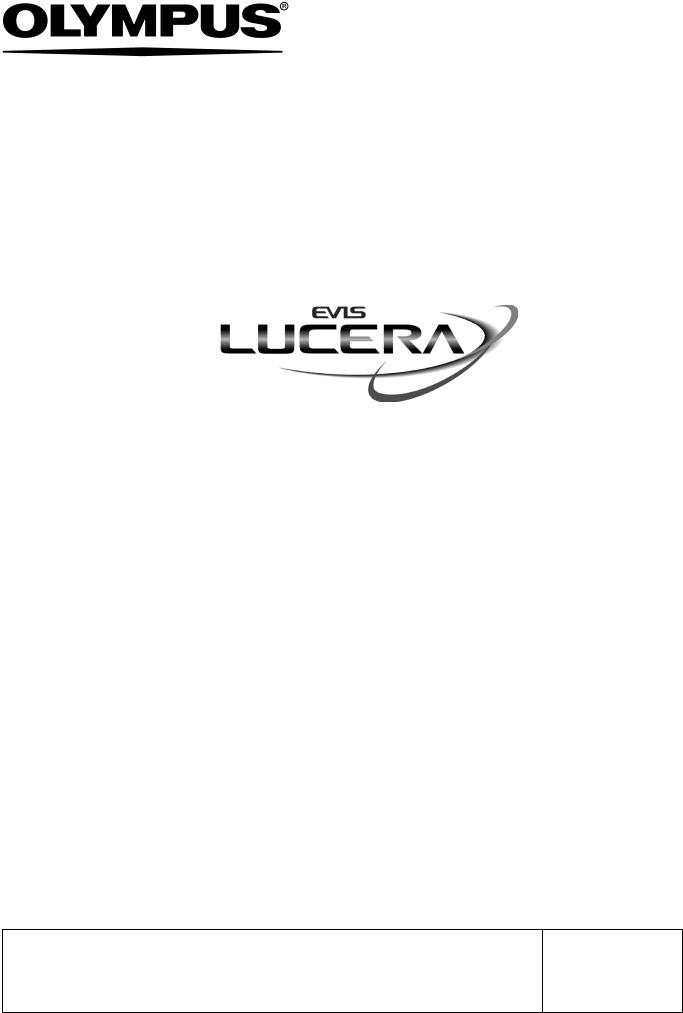
INSTRUCTIONS
EVIS LUCERA GASTROINTESTINAL VIDEOSCOPE
OLYMPUS GIF-N260
OLYMPUS GIF-XP260
OLYMPUS GIF-XQ260
OLYMPUS GIF-Q260
OLYMPUS GIF-H260
OLYMPUS GIF-H260Z
EVIS LUCERA COLONOVIDEOSCOPE
OLYMPUS CF-Q260AL/I OLYMPUS CF-Q260DL/I OLYMPUS CF-H260AL/I OLYMPUS CF-H260AZL/I OLYMPUS PCF-Q260AL/I
Refer to the endoscope’s companion manual, the “REPROCESSING MANUAL” whose cover lists the model of your endoscope, for reprocessing information.

|
|
Contents |
Contents |
|
|
Symbols......................................................................................... |
|
1 |
Important Information — Please Read Before Use.................... |
2 |
|
Intended use ............................................................................................ |
2 |
|
Applicability of endoscopy and endoscopic treatment .............................. |
3 |
|
Instruction manual .................................................................................... |
3 |
|
User qualifications .................................................................................... |
4 |
|
Instrument compatibility ........................................................................... |
4 |
|
Reprocessing before the first use/reprocessing and storage after use..... |
5 |
|
Spare equipment ...................................................................................... |
5 |
|
Maintenance management ....................................................................... |
5 |
|
Prohibition of improper repair and modification ........................................ |
5 |
|
Signal words.............................................................................................. |
6 |
|
Warnings and cautions ............................................................................. |
6 |
|
Examples of inappropriate handling.......................................................... |
12 |
|
Chapter 1 Checking the Package Contents............................ |
13 |
|
Chapter 2 Instrument Nomenclature and Specifications ...... |
18 |
|
2.1 |
Nomenclature.................................................................................. |
18 |
2.2 |
Endoscope functions....................................................................... |
30 |
2.3 |
Specifications.................................................................................. |
33 |
2.4 |
Attaching the chain for water-resistant cap (MAJ-1119) ................. |
46 |
Chapter 3 Preparation and Inspection .................................... |
49 |
|
3.1 |
Preparation of the equipment.......................................................... |
50 |
3.2 |
Inspection of the endoscope ........................................................... |
52 |
3.3 |
Preparation and inspection of accessories ..................................... |
58 |
3.4 |
Attaching accessories to the endoscope ........................................ |
62 |
3.5 |
Inspection and connection of ancillary equipment .......................... |
65 |
3.6 |
Inspection of the endoscopic system .............................................. |
69 |
Chapter 4 |
Operation ................................................................. |
75 |
4.1 |
Insertion .......................................................................................... |
79 |
4.2 |
Using endo-therapy accessories..................................................... |
88 |
4.3 |
Withdrawal of the endoscope.......................................................... |
94 |
4.4 |
Transportation of the endoscope .................................................... |
95 |
EVIS LUCERA GIF/CF/PCF TYPE 260 Series OPERATION MANUAL |
i |

Contents
Chapter 5 |
Troubleshooting ...................................................... |
97 |
5.1 |
Troubleshooting guide .................................................................... |
97 |
5.2 |
Withdrawal of the endoscope with an abnormality.......................... |
102 |
5.3 |
Returning the endoscope for repair................................................. |
105 |
Appendix........................................................................................ |
|
107 |
System chart ............................................................................................ |
107 |
|
EMC information........................................................................................ |
133 |
|
ii |
EVIS LUCERA GIF/CF/PCF TYPE 260 Series OPERATION MANUAL |
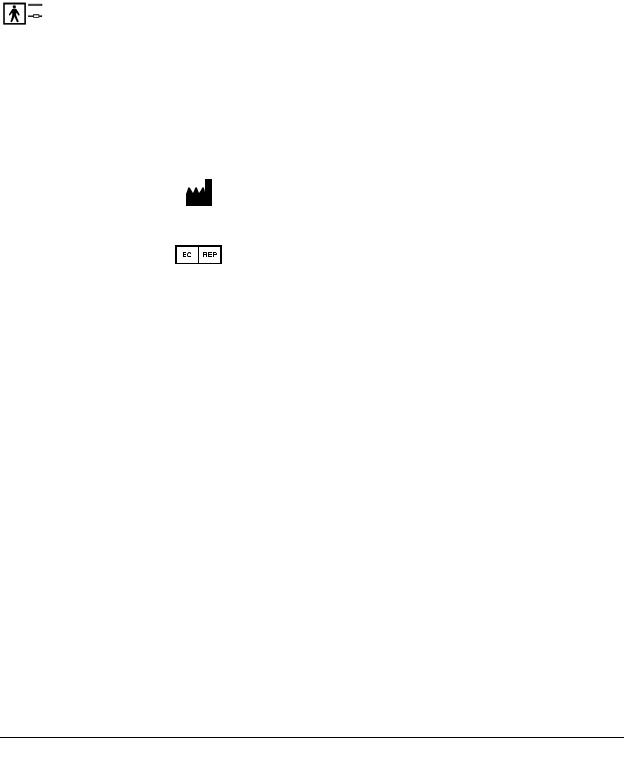
Symbols
Symbols
The meaning(s) of the symbol(s) shown on the package with the components, the back cover of this instruction manual and/or this instrument are as follows:
Refer to instructions.
Endoscope
TYPE BF applied part
Manufacturer
Authorized representative in the European Community
EVIS LUCERA GIF/CF/PCF TYPE 260 Series OPERATION MANUAL |
1 |

Important Information — Please Read Before Use
Important Information — Please Read
Before Use
Intended use
These instruments have been designed to be used with an Olympus video system center, light source, endoscope position detecting unit (for CF-Q260DL/I only), magnification controller (for CF-H260AZL/I only), documentation equipment, monitor, endo-therapy accessories such as a biopsy forceps and other ancillary equipment.
Use the EVIS LUCERA GASTROINTESTINAL VIDEOSCOPE GIF-N260 for transoral or transnasal endoscopy and endoscopic surgery within the upper digestive tract (including the esophagus, stomach and duodenum).
Use the EVIS LUCERA GASTROINTESTINAL VIDEOSCOPE GIF-XP260, GIF-XQ260, GIF-Q260, GIF-H260, GIF-H260Z for endoscopy and endoscopic surgery within the upper digestive tract (including the esophagus, stomach and duodenum).
Use the EVIS LUCERA COLONOVIDEOSCOPE CF-Q260AL/I, CF-H260AL/I, PCF-Q260AL/I, CF-H260AZL/I, CF-Q260DL/I for endoscopy and endoscopic surgery within the lower digestive tract (including the anus, rectum, sigmoid colon, colon and ileocecal valve).
Do not use these instruments for any purpose other than their intended uses. Select the endoscope to be used according to the objective of the intended procedure based on the full understanding of the endoscope’s specifications and functionality as described in this instruction manual.
2 |
EVIS LUCERA GIF/CF/PCF TYPE 260 Series OPERATION MANUAL |

Important Information — Please Read Before Use
Applicability of endoscopy and endoscopic treatment
If there is an official standard on the applicability of endoscopy and endoscopic treatment that is defined by the hospital’s administration or other official institutions such as academic societies on endoscopy, follow that standard. Before starting endoscopy and endoscopic treatment, thoroughly evaluate its properties, purposes, effects, and possible risk (their natures, extent and probability). Perform endoscopy and endoscopic treatment only when its potential benefits are greater than its risks.
Fully explain to the patient the potential benefits and risks of the endoscopy and endoscopic treatment as well as any examination/treatment methods that can be performed in its place, and perform the endoscopy and endoscopic treatment only after obtaining the consent of the patient.
Even after starting the endoscopy and endoscopic treatment, continue to evaluate the potential benefits and risks, and immediately stop the endoscopy/treatment and take proper measures if the risks to the patient become greater than the potential benefits.
Instruction manual
This instruction manual contains essential information on using this instrument safely and effectively. Before use, thoroughly review this manual and the manuals of all equipment which will be used during the procedure and use the equipment as instructed.
Note that the complete instruction manual set for this endoscope consists of this manual and the “REPROCESSING MANUAL” whose cover lists the model of your endoscope. It also accompanied the endoscope at shipment.
Keep this and all related instruction manuals in a safe, accessible location. If you have any questions or comments about any information in this manual, please contact Olympus.
Terms used in this manual
Special light observation:
This is an observation using filtered light.
NBI (Narrow Band Imaging) observation:
This is a special light observation using the narrow band observation light.
EVIS LUCERA GIF/CF/PCF TYPE 260 Series OPERATION MANUAL |
3 |

Important Information — Please Read Before Use
Normal light observation (WLI (White Light Imaging) observation):
This is the ordinary observation using the RGB light.
User qualifications
If there is an official standard on user qualifications to perform endoscopy and endoscopic treatment that is defined by the medical administration or other official institutions, such as academic society on endoscopy, follow that standard. If there is no official qualification standard, the operator of this instrument must be a physician approved by the medical safety manager of the hospital or person in charge of the department (department of internal medicine, etc.).
The physician should be capable of safety performing the planned endoscopy and endoscopic treatment following guidelines set by the academic societies on endoscopy, etc., and considering the difficulty of endoscopy and endoscopic treatment. This manual does not explain or discuss endoscopic procedures.
Instrument compatibility
Refer to the “System chart” in the Appendix to confirm that this instrument is compatible with the ancillary equipment being used. Using incompatible equipment can result in patient or operator injury and/or equipment damage.
This instrument complies with the EMC standard for medical electrical equipment; edition 2 (IEC 60601-1-2: 2001). However, when connected with an instrument that complies with the EMC standard for medical electrical equipment; edition 1 (IEC 60601-1-2: 1993), the whole system complies with edition 1.
4 |
EVIS LUCERA GIF/CF/PCF TYPE 260 Series OPERATION MANUAL |

Important Information — Please Read Before Use
Reprocessing before the first use/reprocessing and storage after use
This instrument was not cleaned, disinfected or sterilized before shipment. Before using this instrument for the first time, reprocess it according to the instructions given in the endoscope’s companion manual, the “REPROCESSING MANUAL” whose cover lists the model of your endoscope.
After using this instrument, reprocess and store it according to the instructions given in the endoscope’s companion reprocessing manual. Improper and/or incomplete reprocessing or storage can present an infection-control risk, cause equipment damage or reduce performance.
Spare equipment
Be sure to prepare another endoscope to avoid that the examination will be interrupted due to equipment failure or malfunction.
Maintenance management
The probability of failure of the endoscope and ancillary equipment increases as the number of procedures performed and/or the total operating hours increase. In addition to the inspection before each procedure, the person in charge of medical equipment maintenance in each hospital should inspect the items specified in this manual periodically. An endoscope with which an irregularity is suspected should not be used, but should be inspected by following Section 5.1, “Troubleshooting guide” on page 97. If the irregularity is still suspected after inspection, contact Olympus.
Prohibition of improper repair and modification
This instrument does not contain any user-serviceable parts. Do not disassemble, modify or attempt to repair it; patient or operator injury and/or equipment damage can result.
Equipment which has been disassembled, repaired, altered, changed or modified by persons other than Olympus’ own authorized service personnel is excluded from Olympus’ limited warranty and is not warranted by Olympus in any manner.
EVIS LUCERA GIF/CF/PCF TYPE 260 Series OPERATION MANUAL |
5 |

Important Information — Please Read Before Use
Signal words
The following signal words are used throughout this manual:
Indicates a potentially hazardous situation which, if not avoided, could result in death or serious injury.
Indicates a potentially hazardous situation which, if not avoided, may result in minor or moderate injury. It may also be used to alert against unsafe practices or potential equipment damage.
Indicates additional helpful information.
Warnings and cautions
Follow the warnings and cautions given below when handling this instrument. This information is to be supplemented by the warnings and cautions given in each chapter.
•After using this instrument, reprocess and store it according to the instructions given in the endoscope’s companion reprocessing manual whose cover lists the model of your endoscope. Using improperly or incompletely reprocessed or stored instruments may cause patient cross-contamination and/or infection.
•Before endoscopy, remove any metallic objects (watch, glasses, necklace, etc.) from the patient. If performing high-frequency cauterization treatment becomes necessary while the patient wears a metallic object, it may cause burns on the patient in areas around the metallic object.
•Do not strike, bend, hit, pull, twist, or drop the endoscope’s distal end, insertion tube, bending section, control section, universal cord, or endoscope connector of the endoscope with excessive force. The endoscope may be damaged and could cause patient injury, burns, bleeding and/or perforations. It could also cause parts of the endoscope to fall off inside the patient.
6 |
EVIS LUCERA GIF/CF/PCF TYPE 260 Series OPERATION MANUAL |

Important Information — Please Read Before Use
•When performing transnasal insertion of the GIF-N260, please follow the cautions below.
−The shape and size of the nasal cavity and its suitability for transnasal insertion may vary from patient to patient. No endoscope, including this one, can always be inserted transnasally with all patients. Before proceeding, always be sure to confirm that transnasal insertion is possible with the patient by always considering both the size of the patient’s nasal cavity as well as the size of the endoscope’s insertion tube. Otherwise, operator and/or patient injury can result or the endoscope could become lodged and be difficult to withdraw.
−Transnasal insertion is accompanied by the risk of inflammation of the nasal cavity. If this happens, the nasal passage will be constricted, making it more difficult to withdraw the endoscope. In this case, do not use force to withdraw the endoscope because patient injury such as bleeding or perforation may result.
−Transnasal insertion is accompanied by the risk of bleeding in the nasal cavity. Be sure to be prepared to deal with any bleeding. When withdrawing the endoscope, observe the inside of the nasal cavity to ensure that there is no bleeding. Even when the endoscope has been withdrawn without bleeding, do not allow the patient to blow his or her nose strongly because this could cause it to start bleeding.
−Before transnasal insertion, apply the appropriate pretreatment and lubrication to the patient to enlarge the nasal cavity. Otherwise, operator and/or patient injury can result or the endoscope could become lodged and be difficult to withdraw. When applying a pretreatment agent through a tube, insert the tube into the same path as the path planned for the endoscope insertion. Otherwise, the treatment will have no effect. The effects of the pretreatment agent and lubricant will decrease the longer the procedure lasts. Apply the pretreatment agent or lubricant as required during the procedure – for example, when withdrawal seems to be difficult.
−Transnasal insertion of the endoscope should be performed carefully. If resistance to insertion is felt, or the patient reports pain, stop insertion immediately. Otherwise, operator and/or patient injury can result or the endoscope could become lodged and be difficult to withdraw.
EVIS LUCERA GIF/CF/PCF TYPE 260 Series OPERATION MANUAL |
7 |

Important Information — Please Read Before Use
−If it becomes impossible to withdraw the transnasally inserted endoscope, pull its distal end out of the mouth, cut the flexible tube using wire cutters, and after ensuring that the cut section will not injure the body cavity or nasal cavity of the patient, withdraw the endoscope carefully. Therefore, always prepare wire cutters in advance.
•Never perform angulation control forcibly or abruptly. Never forcefully pull, twist or rotate the angulated bending section. Patient injury, bleeding and/or perforation can result. It may also become impossible to straighten the bending section during an examination.
•Never insert or withdraw the endoscope’s insertion tube while the bending section is locked in position. Patient injury, bleeding and/or perforation can result.
•Never perform flexibility adjustment, operate the bending section, feed air or perform suction, insert or withdraw the endoscope’s insertion tube, or use endo-therapy accessories without viewing the endoscopic image. Patient injury, bleeding and/or perforation can result.
•Never perform flexibility adjustment, operate the bending section, feed air or perform suction, insert or withdraw the endoscope’s insertion tube, or use endo-therapy accessories while the image is frozen. Patient injury, bleeding and/or perforation can result.
•Regardless of the flexibility of the endoscope’s insertion tube, never insert or withdraw the insertion tube abruptly or with excessive force. Patient injury, bleeding and/or perforation can result.
•The bending section will never bend to the RIGHT or LEFT direction but to the UP or DOWN direction. To insert or withdraw, operate the endoscope by considering the direction in which the bending section is angulated. Never apply excessive force to the RIGHT or LEFT direction when inserting or withdrawing the endoscope. Patient injury, bleeding and/or perforation can result (for GIF-N260 only).
•Never insert or withdraw the endoscope’s insertion tube, use endo-therapy accessories while the image is magnified. Patient injury, bleeding and/or perforation can result (when using the GIF-H260Z, CF-H260AZL/I or using the image magnification function of the video system center).
•Do not touch the light guide of the endoscope connector immediately after removing it from the light source because it is extremely hot. Operator or patient burns can result.
8 |
EVIS LUCERA GIF/CF/PCF TYPE 260 Series OPERATION MANUAL |
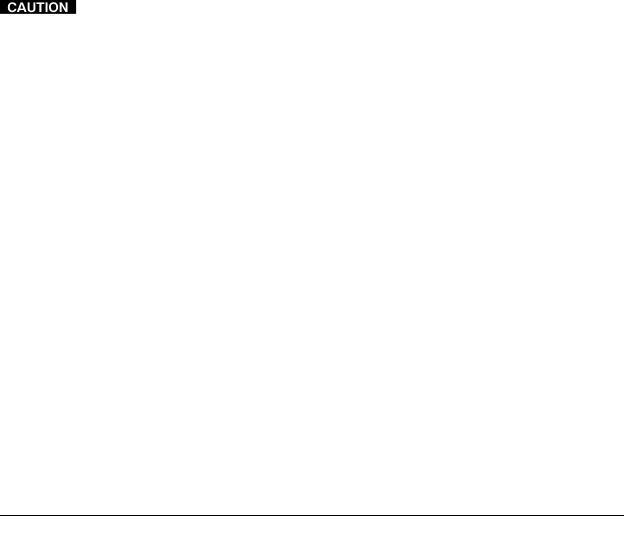
Important Information — Please Read Before Use
•When the endoscopic image does not appear on the monitor, the CCD may have been damaged. Turn the video system center OFF immediately. Continued power supply in such a case will cause the distal end to become hot and could cause operator and/or patient burns.
•If it is difficult to insert the endoscope, do not forcibly insert the endoscope; stop the endoscopy. Forcible insertion can result in patient injury, bleeding and/or perforation.
•When combining the endoscope with a splinting tube, there is the risk of perforation or bleeding due to entanglement of the mucous membrane, or of the tube to become separated from the endoscope and remaining in the body. Before use, be sure to read the instruction manual for the splinting tube to fully understand its characteristics.
•Do not rely on the NBI imaging modality alone for primary detection of lesions or to make a decision regarding any potential diagnostic or therapeutic intervention.
•Do not pull the universal cord during an examination. The endoscope connector will be pulled out from the output socket of the light source and the endoscopic image will not be visible.
•Do not coil the insertion tube or universal cord with a diameter of less than 12 cm. Equipment damage can result.
•Do not touch the electrical contacts inside the electrical connector. CCD damage may result.
•Do not apply shock to the distal end of the insertion tube, particularly the objective lens surface at the distal end. Visual abnormalities may result.
•Do not twist or bend the bending section with your hands. Equipment damage may result.
•Do not squeeze the bending section forcefully. The covering of the bending section may stretch or break and cause water leaks.
EVIS LUCERA GIF/CF/PCF TYPE 260 Series OPERATION MANUAL |
9 |

Important Information — Please Read Before Use
•Turn the video system center OFF before connecting or disconnecting the videoscope cable from the electrical connector on the endoscope. Turn the video system center ON or OFF only when the videoscope cable is connected to both the video system center and the electrical connector on the endoscope. Failure to do so can result in equipment damage, including destruction of the CCD.
•The endoscope’s remote switches cannot be removed from the control section. Pressing, pulling or twisting them with excessive force can break the switches and/or may cause water leaks.
•If remote switch 1 does not return to the OFF position after being pressed strongly from the side, gently pull the switch upwards to return it to the OFF position.
•Do not hit or bend the electrical contacts on the endoscope connector. The connection to the light source may be impaired and faulty contact can result.
•Do not attempt to bend the endoscope’s insertion tube with excessive force. Otherwise, the insertion tube may be damaged.
•Do not attempt to bend the endoscope’s insertion tube with excessive force unless its flexibility is set to the most-rigid position. Otherwise, the insertion tube may be damaged (for endoscopes with flexibility adjustment only).
•Do not pull the magnification control cable during an examination. The endoscope connector will be pulled out from the output socket of the light source and the endoscopic image will not be visible. The magnification control cable will be pulled out from the endoscope’s zoom connector and the endoscopic image will not zoom in or out (for CF-H260AZL/I only).
•Turn the magnification controller OFF before connecting or disconnecting the magnification control cable from the endoscope’s zoom connector. Failure to do so can result in equipment damage (for CF-H260AZL/I only).
•Do not pull the UPD cable during an examination. The endoscope connector will be pulled out from the output socket of the light source and the endoscopic image will not be visible. The UPD cable will be pulled out from the UPD scope connector and the scope model will not be visible (for CF-Q260DL/I only).
10 |
EVIS LUCERA GIF/CF/PCF TYPE 260 Series OPERATION MANUAL |

Important Information — Please Read Before Use
•Turn the endoscope position detecting unit (UPD) OFF before connecting or disconnecting the UPD cable from the UPD scope connector. Turn the UPD ON or OFF only when the UPD cable is connected to the UPD scope connector. Failure to do so can result in UPD damage (for CF-Q260DL/I only).
•To check the electromagnetic influence from other equipment (any equipment other than this instrument or the components that constitute this system), the system should be observed to verify its normal operation in the configuration in which it will be used.
•Electromagnetic interference may occur on this instrument near equipment marked with the following symbol or other portable and mobile RF (Radio Frequency) communications equipment such as cellular phones. If electromagnetic interference occurs, mitigation measures may be necessary, such as reorienting or relocating this instrument, or shielding the location.
This endoscope contains a memory chip that stores information about the endoscope and communicates this information to the video system center CV-260SL, CV-260.
EVIS LUCERA GIF/CF/PCF TYPE 260 Series OPERATION MANUAL |
11 |

Important Information — Please Read Before Use
Examples of inappropriate handling
Details on clinical endoscopic technique are the responsibility of trained specialists. Patient safety in endoscopic examinations and endoscopic treatment can be ensured through appropriate handling by the physician and the medical facility. Examples of inappropriate handling are described below;
•Over-insufflating the lumen may cause patient pain, injury, bleeding and/or perforation.
•Applying suction with the distal end in prolonged contact with the mucosal surface, with higher suction pressure than required or with prolonged suction time may cause bleeding and/or lesions.
•The endoscope has not been designed for use in retroflexed observation in parts of the body other than the stomach. Performing retroflexed observation in a narrow lumen may make it impossible to straighten and/or withdraw the endoscope. Retroflexed observation in parts of the body other than the stomach should be performed only when the usefulness of doing so is determined to be greater than the risk that is posed to the patient.
•Inserting, withdrawing and using endo-therapy accessories without a clear endoscopic image may cause patient injury, burns, bleeding and/or perforation.
•Inserting or withdrawing the endoscope, feeding air, applying suction or operating the bending section without a clear endoscopic image may cause patient injury, bleeding and/or perforation.
12 |
EVIS LUCERA GIF/CF/PCF TYPE 260 Series OPERATION MANUAL |

Chapter 1 Checking the Package Contents
Chapter 1 Checking the Package
Contents
Match all items in the package with the components shown below. Inspect each item for damage. If the instrument is damaged, a component is missing or you have any questions, do not use the instrument; immediately contact Olympus. This instrument was not disinfected or sterilized before shipment.
Before using this instrument for the first time, reprocess it according to the instructions described in the endoscope’s companion manual, the “REPROCESSING MANUAL” whose cover lists the model of your endoscope.
EVIS LUCERA GIF/CF/PCF TYPE 260 Series OPERATION MANUAL |
13 |

Chapter 1 Checking the Package Contents
GIF-N260 |
Endoscope |
GIF-XP260, GIF-XQ260, GIF-Q260, GIF-H260 |
Endoscope |
GIF-H260Z |
Endoscope |
14 |
EVIS LUCERA GIF/CF/PCF TYPE 260 Series OPERATION MANUAL |
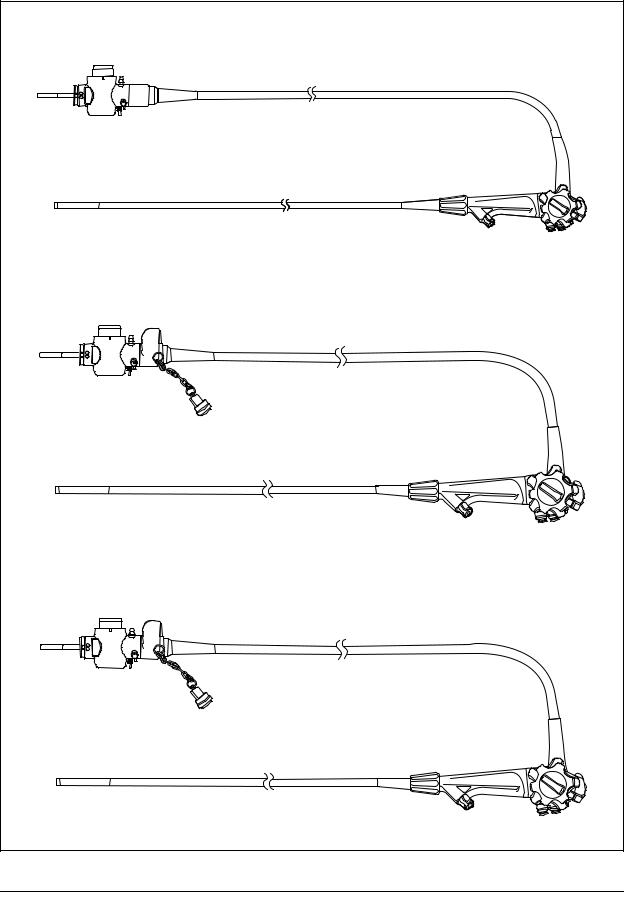
Chapter 1 Checking the Package Contents
CF-Q260AL/I, CF-H260AL/I, PCF-Q260AL/I |
Endoscope |
CF-H260AZL/I |
Endoscope |
CF-Q260DL/I |
Endoscope |
EVIS LUCERA GIF/CF/PCF TYPE 260 Series OPERATION MANUAL |
15 |

Chapter 1 Checking the Package Contents
Channel cleaning brush (BW-20T)
Water-resistant cap (MH-553)
Injection tube (MH-946)
Channel-opening cleaning |
AW channel cleaning |
|
brush (MH-507) |
adapter (MH-948) |
|
|
Suction valve |
Air/water valve |
Channel plug (MH-944) |
|
(MH-443) (2 pcs) |
(MH-438) (2 pcs) |
||
|
Biopsy valve |
Suction cleaning adapter |
Chain for water-resistant cap (MAJ-1119) |
(MB-358) (10 pcs) |
(MH-856) |
Auxiliary water tube (MAJ-855) (for GIF-H260Z only)
Mouthpiece
(MB-142 for GIF-XQ260, GIF-Q260, GIF-H260, GIF-H260Z) (2 pcs)
Mouthpiece (MA-474, MB-142 for GIF-N260, GIF-XP260) (1 pc each)
|
|
Instructions (leaflet type, |
Operation manual |
Reprocessing manual |
for endoscopes with |
|
|
flexibility adjustment only) |
16 |
EVIS LUCERA GIF/CF/PCF TYPE 260 Series OPERATION MANUAL |

Chapter 1 Checking the Package Contents
EVIS LUCERA GIF/CF/PCF TYPE 260 Series OPERATION MANUAL |
17 |

Chapter 2 Instrument Nomenclature and Specifications
Chapter 2 Instrument Nomenclature
and Specifications
2.1Nomenclature
GIF-N260
Universal cord
5. Electrical connector
Air pipe
1.Suction connector
26.Chain connector
3. Air supply connector
3. Water supply connector
Light guide
Product name and serial number
Electrical contacts
4. Endoscope connector
18 |
EVIS LUCERA GIF/CF/PCF TYPE 260 Series OPERATION MANUAL |
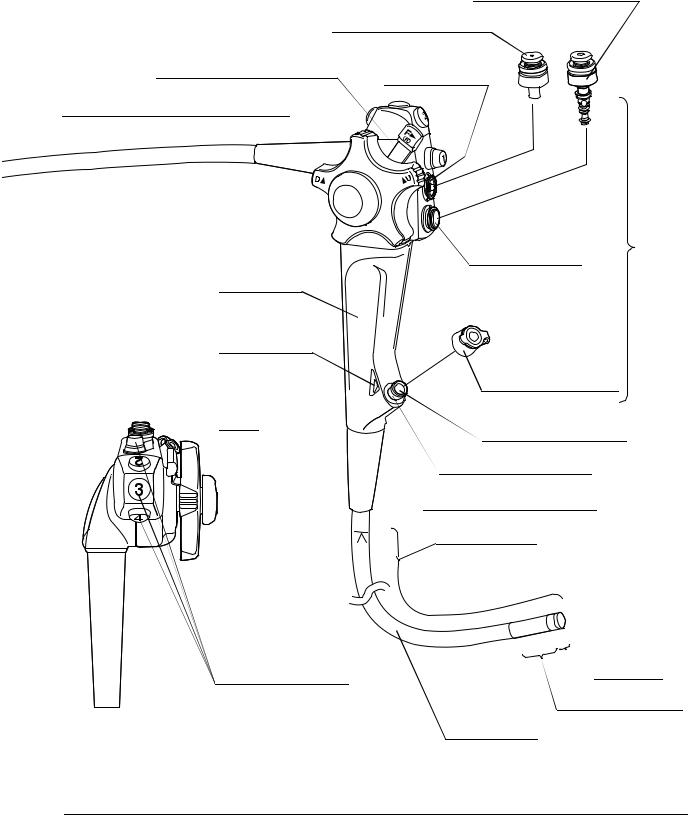
Chapter 2 Instrument Nomenclature and Specifications
7.UP/DOWN angulation lock
6.UP/DOWN angulation control knob
Grip section
14. Color code
9.Air/water valve (MH-438)
8.Suction valve (MH-443)
Suction cylinder
|
Control |
Air/water cylinder |
section |
Biopsy valve (MB-358)
Boot
10. Instrument channel Instrument channel port
11. Insertion tube limit mark
Working length
|
13. Remote switches |
Distal end |
|
|
|
|
|
12. Bending section |
Top view |
|
Insertion tube |
|
|
EVIS LUCERA GIF/CF/PCF TYPE 260 Series OPERATION MANUAL |
19 |

Chapter 2 Instrument Nomenclature and Specifications
GIF-XP260, GIF-XQ260, GIF-Q260, GIF-H260
|
|
1. Suction connector |
|
|
5. Electrical connector |
|
26. Chain connector (for GIF-XP260 only) |
||
|
|
|
|
|
Air pipe
Universal cord
3. Air supply connector
3. Water supply connector
Light guide
Product name and serial number
Electrical contacts
4. Endoscope connector
1. Suction connector
5. Electrical connector 2. S-cord connector mount (except GIF-XP260)
Air pipe
|
3. Air supply connector |
|
3. Water supply connector |
Light guide |
Product name and serial number |
|
|
|
Electrical contacts |
|
4. Endoscope connector |
20 |
EVIS LUCERA GIF/CF/PCF TYPE 260 Series OPERATION MANUAL |
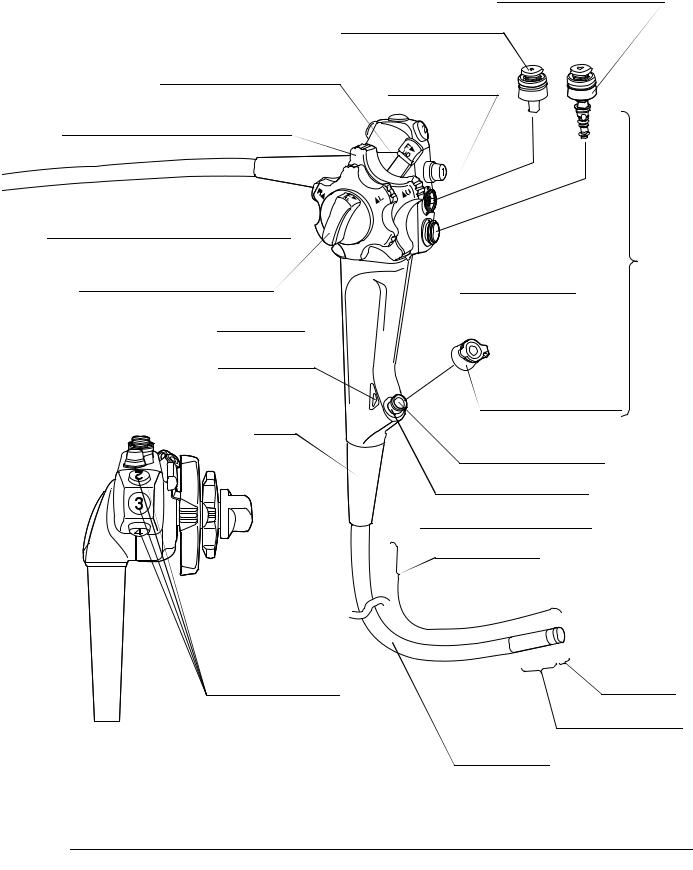
Chapter 2 Instrument Nomenclature and Specifications
9. Air/water valve (MH-438)
8. Suction valve (MH-443)
7. UP/DOWN angulation lock
Suction cylinder
6. UP/DOWN angulation control knob
16. RIGHT/LEFT angulation control knob
Control section
15. RIGHT/LEFT angulation lock |
Air/water cylinder |
Grip section  14. Color code
14. Color code
Biopsy valve (MB-358)
Boot
10. Instrument channel Instrument channel port
11. Insertion tube limit mark  Working length
Working length
13. Remote switches |
Distal end |
12. Bending section
Top view
Insertion tube
EVIS LUCERA GIF/CF/PCF TYPE 260 Series OPERATION MANUAL |
21 |

Chapter 2 Instrument Nomenclature and Specifications
GIF-H260Z
Universal cord
19. Auxiliary water inlet
1. Suction connector |
Auxiliary water inlet cap |
|
(MAJ-215) |
5. Electrical connector |
|
Air pipe |
|
|
2. S-cord connector mount |
|
3. Air supply connector |
|
3. Water supply connector |
Light guide |
Product name and serial number |
|
|
|
Contact pins |
|
4. Endoscope connector |
22 |
EVIS LUCERA GIF/CF/PCF TYPE 260 Series OPERATION MANUAL |

Chapter 2 Instrument Nomenclature and Specifications
9. Air/water valve (MH-438)
8. Suction valve (MH-443)
7. UP/DOWN angulation lock
Suction cylinder
6. UP/DOWN angulation control knob
18. Zoom lever
16.RIGHT/LEFT angulation control knob
|
Control |
Air/water cylinder |
section |
15. RIGHT/LEFT angulation lock
Grip section 14. Color code
Biopsy valve (MB-358)
10. Instrument channel
Boot
Instrument channel port
11. Insertion tube limit mark
Working length
13. Remote switches 1 to 4
Distal end
12. Bending section
Insertion tube
Top view
EVIS LUCERA GIF/CF/PCF TYPE 260 Series OPERATION MANUAL |
23 |

Chapter 2 Instrument Nomenclature and Specifications
CF-Q260AL, CF-Q260AI, CF-H260AL, CF-H260AI, PCF-Q260AL, PCF-Q260AI
Universal cord
1. Suction connector
5. Electrical connector |
2. S-cord connector mount |
|
Air pipe
3. Air supply connector
3. Water supply connector
Light guide
Product name and serial number
Electrical contacts
4. Endoscope connector
24 |
EVIS LUCERA GIF/CF/PCF TYPE 260 Series OPERATION MANUAL |
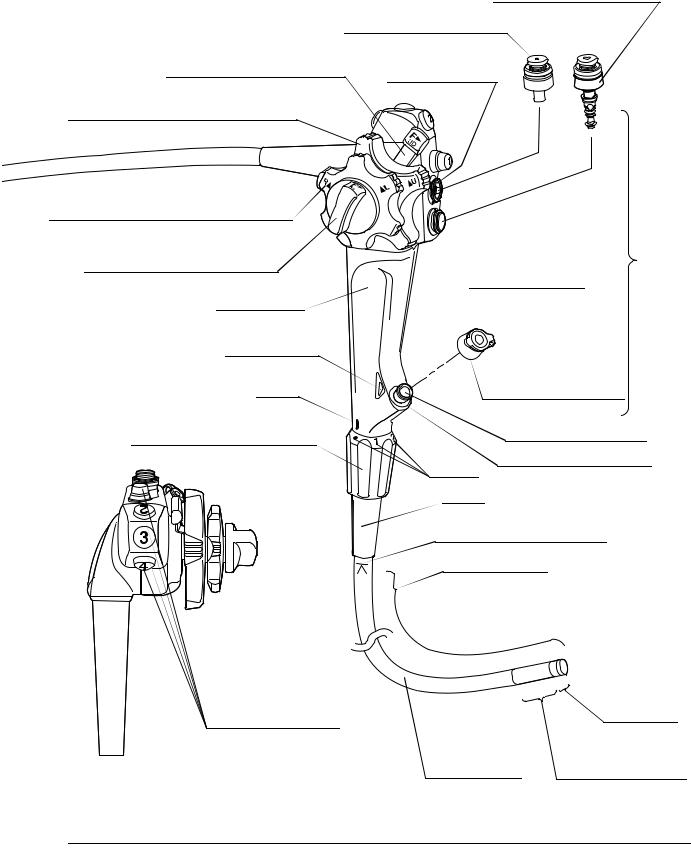
Chapter 2 Instrument Nomenclature and Specifications
9. Air/water valve (MH-438)
|
8. Suction valve (MH-443) |
7. UP/DOWN angulation lock |
Suction cylinder |
|
|
6. UP/DOWN angulation control knob |
|
16. RIGHT/LEFT angulation control knob |
|
15. RIGHT/LEFT angulation lock |
Control |
section |
|
|
Air/water cylinder |
Grip section |
|
14. Color code |
|
Mark |
Biopsy valve (MB-358) |
17. Flexibility adjustment ring |
10. Instrument channel |
|
|
|
Instrument channel port |
|
Marks |
|
Boot |
|
11. Insertion tube limit mark |
|
Working length |
|
13. Remote switches |
Distal end |
|
|
|
Top view |
Insertion tube |
12. Bending section |
EVIS LUCERA GIF/CF/PCF TYPE 260 Series OPERATION MANUAL |
25 |

Chapter 2 Instrument Nomenclature and Specifications
CF-H260AZL, CF-H260AZI
Mark3
22. Seal ring
Front view of the zoom scope connector
Universal cord 1. Suction connector
5. Electrical connector |
2. S-cord connector mount |
|||
|
|
|
20. Zoom connector |
|
Air pipe
21. Water-resistant cap (MAJ-583)
3. Air supply connector
Light guide
3. Water supply connector
Electrical contacts Product name and serial number
4. Endoscope connector
26 |
EVIS LUCERA GIF/CF/PCF TYPE 260 Series OPERATION MANUAL |
